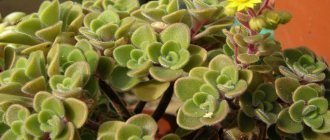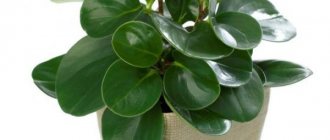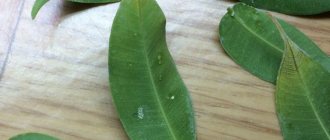In nature, ficus trees, among which there are trees, shrubs, and vines, often reach a height of several tens of meters, but through the efforts of breeders they have long been adapted for cultivation indoors. Ficus Melanie is a prime example of such a “tamed” exotic. Its distinctive feature is its compactness. The small size of this ornamental tree allows it to be grown even in extremely limited spaces.
By providing your ficus with proper care, you will grow a resilient, durable plant that can live for as long as fifty years!
How to choose
You need to buy Melanie in spring or summer, choosing a young, healthy plant - this way it will better take root in new conditions. The leaves should sit firmly on the branches without falling off. To check, it is recommended to stroke the bush “against the leaves” and see if they all remain in place. At home, wipe the ficus with a wet cloth, since sellers may have treated the leaves with polish for shine. Place it away from other plants for a few weeks and monitor it for diseases and pests.
This variety is quite common and can be easily found in a store (or bought secondhand). The average price for an adult specimen with a height of 50-55 cm is 1,500 rubles. A young ficus 20-25 cm tall is sold for 400-500 rubles. Variegated plants may cost more, but not significantly.
What conditions need to be created at home?
A young ficus adapts better to housing and climatic conditions than a more mature plant. Therefore, it is better to buy a small young ficus. Keeping it in a medium-sized pot will help curb its growth if you want it to be small.
As with other plants, care must be taken about where to place and how to create optimal conditions for growth. Crucial to growing is the correct balance of water and light. You can control both parameters.
Selecting a location
Ficus prefers indirect light and can grow in poorly lit areas of the apartment. Some gardeners recommend placing Melanie next to a window with transparent curtains.
Did you know? The milky sap of ficus trees was used to make rubber in the early 1900s.
This gives enough light, but not too much.
Air temperature and humidity
The ideal air temperature is +16…+24°C. But Melanie also grows well at daytime temperatures of +21...+28°C. Temperatures above +28°C cause rapid evaporation of moisture, which leads to leaf damage and drought.
Colder temperatures inhibit ficus growth and can also cause the tree to go dormant during the growing season. Night temperature should not drop lower than 10 degrees compared to daytime.
Keep the ficus away from sources of artificial heating of the room. They dry out the foliage and soil, which can damage the ficus. Melanie tolerates low temperatures well if she is in a dormant period. It is also undesirable to install the pot in a draft.
The ideal humidity level for a tropical plant is 60–80%. But it is difficult to maintain indoors. To create a humidity level of 70%, you need to place the pot in a tray with wet pebbles and some water.
Description
Melanie Elastica is a compact plant reaching a height of 60-65 cm. Ficus bushes beautifully, forming a lush crown with shiny leaves. The leaves are distinguished by their oblong shape with a narrowed, sharp tip. Dense, glossy, leathery, densely located on the stem.
The length of the leaf is 12-15 cm, the width is no more than 7-8 cm. It is dark green on top and olive green on the bottom. The upper vein is light, the lower one is reddish. New leaves on a healthy plant grow quickly - one each week. With age, it develops aerial roots, but flowering at home cannot be expected.
What does Ficus Melanie look like, what family does it belong to?
This plant is so compact that it is suitable for cultivation in any room. Ficus variety Melanie has a beautiful crown. The densely planted leaves make the plant especially attractive.
Growing ficus rubber
The length of the leaf plates is about 13 cm. Their surface is glossy, and the reverse side, on the contrary, is matte. On a light green background you can see many reddish veins. The vertical option of growing the plant allows you to achieve large branching. Pruning will help give the bush any shape.
Common varieties
The most common varieties of rubber-bearing ficus are:
- Abidjan - the plant loves bright light, has oval leaves of a dark green color, pointed at the end.
- Belize - a feature of the variety is white and pink stains along the edges of the leaf plate.
- Melanie - this ficus has dense foliage, the length of the plate is 15 cm.
- Robusta - the variety is the most unpretentious, the leaf length is 30 cm, the shape is ellipsoidal.
- Black Prince - the foliage color of this variety is the darkest of all. The leaves are round, their shade changes in accordance with changes in the light in the room.
- Tineke is a variegated variety; along the edges of the foliage you can see a white or cream border.
- Shriveriana - ellipsoidal foliage has a marble color, the length of the plate is 25 cm and the width is 18 cm.
- Tricolor is a variegated variety, the foliage has an interesting marble pattern.
- Decor – dark green foliage with a burgundy tint, the length of the plate is 18 cm.
Ficus Shriveriana
Medicinal properties
The juice of this plant is good for hard-to-heal wounds and boils. Dry ficus leaves are used in the treatment of rheumatism and hemorrhoids. The leaves are also used in gynecology and oncology. Inflammatory processes can be easily relieved with a tincture of the plant's roots.
Briefly about the history of appearance
In one of the greenhouses in Holland, which is considered the birthplace of the plant, an interesting bush appeared, which mutated completely independently from the ficus elastica Decor. Scientists took cuttings for rooting. After propagation, the result was an excellent hybrid that retained the characteristics of the mother bush in full. This is how it turned out to isolate a new variety, which was given the name Melanie.
Growing conditions
To successfully grow a rubber-bearing ficus, it needs to create comfortable conditions:
- Good lighting, but not in direct sunlight. (It is better to place the flowerpot in the southern part of the room and gradually rotate it so that all the leaves reach towards the sun, forming a beautiful crown.)
- The permissible temperature range is from 15°C to 30°C, but the most desirable is from 22°C to 25°C. (In the hot summer, the leaves need to be moistened by wiping with a sponge).
- Normal humidity for ficus is 45-60%. (In dry and hot weather, plants need to be sprayed with a spray bottle).
Trimming
It is recommended to carry out formative pruning in February or March. When pruning, it is important not to cut the top of the branches below the five internodes. This is quite enough for the bush to activate tillering and acquire a more lush and voluminous appearance.
When pruning, it is important to consider that ficus is a poisonous species. If its juice gets on open skin, burns may develop, so pruning should only be done with gloves.
Systematic pruning will allow you to form a beautiful crown and maintain its condition without much difficulty.
Transfer rules
Ficus Melanie does not need frequent transplants. Replant only in cases where the root system becomes crowded in the flowerpot. If the plant was purchased in a small glass, it is better to immediately transplant it into a larger container.
The best time for this procedure is spring or the first month of summer. It is carried out using the transfer method: the flower is removed from the container along with the earthen lump and transferred to a new pot. A special nutrient substrate for ficus plants is used as additional soil. After replanting, water the plant (and continue to do regular watering as the soil dries).
How to prepare a plant for the procedure?
To understand how to properly prepare a ficus for a traumatic procedure, you need to understand at least a little about its physiology. First you need to know where new branches come from. Option two: new shoots are formed from axillary buds, which are located in places where the petioles are attached to the main trunk, as well as from apical buds, which are located on the crown. The apical bud always develops very actively; the ficus spends a lot of vital energy on its development. Consequently, he simply does not have enough energy to develop the remaining buds, and they develop more slowly.
The plant itself does not require special preparation, but you will definitely have to take care of preparing the tool. You will need pruning shears and a sharp knife. It is important to disinfect the instruments before starting the procedure, so that God forbid you do not introduce an infection into the plant. In addition, it is worth preparing charcoal powder in advance: simply crush the charcoal in a mortar. After making the cut, take a damp cloth and blot the cut area as many times as necessary to absorb the juice. After this, the wound needs to be sprinkled with coal powder - and the job can be considered done.
Care
Excellent and picky flower
Caring for the plant is not difficult - just follow a few simple rules:
- Watering is carried out as needed when the top layer of soil dries out. Water moderately, using lukewarm, settled water. Overmoistening creates an even greater danger for this flower than drying out the soil.
- Melanie needs timely feeding: in summer - more often (every two weeks), in winter - less often (monthly). Universal complexes for indoor plants are suitable as fertilizers.
- Pruning is carried out in late winter (or early spring) to form a lush crown. In young bushes, the growing point is pruned; in adults, 5-6 internodes are cut from above.
How to care at home
By keeping not only the climate healthy, but also the soil, you will get a beautiful and healthy plant. Care consists of regular watering, as well as pruning and replanting. It should be taken into account that ficus is a fast-growing plant and requires a large amount of nutrients.
Find out also about the peculiarities of growing ficuses such as pumila, Abidjan, and Bengal.
Watering
When growing Melanie, it is important to maintain relatively high humidity around the plant. Therefore, watering is carried out if the top part of the soil seems dry to the touch.
Please note that water requirements depend on the season. During the growing season (summer), the plant should be moist. You can spray the plant with moisture from a spray bottle or wipe the leaves with a damp cloth. In autumn and winter you will only need watering once or twice a month.
If the leaves turn yellow and fall off, then the plant does not have enough water.
Important! Cold tap water is settled and brought to room temperature. This evaporates the chlorine contained in the water, which can cause disease in the root system.
Top dressing
During the spring and summer, Melanie is in the vegetative phase and requires monthly fertilization. In winter and autumn there is a dormant period and fertilizers are applied once every 2 months. A universal fertilizer with equal proportions of nitrogen, phosphorus and potassium is suitable for the plant.
If you are unsure whether the plant needs to be fertilized, use half the dosage of fertilizer. This will keep your ficus in excellent condition and you will know you haven't added too much. Always follow package directions when applying fertilizer.
Trimming
Ficus trees do not require significant pruning. But to form the desired height of the plant, it is necessary to cut off the top. After it is cut, the ficus begins to branch. Annual pruning of individual branches will create a denser crown or give it a special shape.
To trim a ficus, you will need pruning shears, the blades of which have been wiped with alcohol. Pruning is done in late winter or early spring, before new leaves appear. Make cuts on branches just above a leaf node or branching stem.
Dead branches are removed immediately at any time of the year. You need to cut it so as not to damage the trunk.
Did you know? Melanie - extremely effective at filtering the air and eliminating toxins. Ficus does this even better than a mid-price air purifier.
Transfer
If you do not replant the plant annually, it will not grow. But you should not plant ficus in a large pot - this will contribute to stagnation of moisture in the soil and rotting of the roots. Transplanting into a pot 3 cm larger than the previous one is the most correct.
Basic rules for transplanting ficus trees:
- Organize replanting in spring or fall. If you can wait until spring, then this is the optimal season for replanting.
- Carefully remove the ficus from the pot. To do this, turn it upside down and squeeze both sides. Someone should hold the ficus at this time.
- Choose a pot that is 2-3cm larger than the previous one or slightly larger than the root ball. Make sure the new one has drainage holes at the bottom.
- Inspect your plant's root system, removing any damaged roots or any that look diseased. It is allowed to trim up to 20% of the root system if it is too large. Do not cut off the central roots!
- Place a layer of pebbles at the bottom of the pot for drainage. Layer thickness - 2.5 cm.
- Fill the pot with well-draining peat soil or store-bought soil.
- Place the ficus in the pot and fill the remaining space with soil until you reach the same level as the soil was before replanting.
- Place the pot in an area with soft light and soft lighting.
- Water the transplanted plant.
Reproduction
At home, two methods of propagation are used: cuttings and air layering. A healthy leaf is selected from the plant, cut off and kept in water (in a glass or under running water) until the milky juice stops flowing. Then it is placed in a glass with Kornevin solution. You can wait for the roots to form directly in the water or place the cuttings in a special substrate (peat, river sand and sphagunm). For successful root formation, high humidity is required, for which the ficus is placed in a greenhouse.
A useful nuance: it is convenient to use the top of the bush, which remains after pruning, as a cutting.
To propagate in the second way, the stem under the leaf is cut vertically. The match is dipped into Kornevin powder and inserted into the incision. Wrap this area with damp moss using film. After 2-3 months, roots appear, after which the cuttings are cut off and replanted.
What can harm the plant
Most often, the plant begins to deteriorate due to poor quality care or lack of nutrition and vitamins (which is often manifested by loss of color saturation and further falling of leaves). If the leaves become covered with yellow spots and become dry and lifeless, then it is necessary to reduce watering, allowing the soil to dry, and then sometimes loosen the substrate. When leaves wrinkle, you should look for the cause in excessively dry air in the apartment.
Pests can also cause problems with the plant. The most dangerous influences are spider mites, mealybugs, thrips and scale insects. In the first case, the attack begins from the bottom of the leaves and manifests itself by the presence of white cobwebs and falling leaves. For treatment, spraying with pyrethrum is used for a week. As for the scale insect, it affects the entire surface of the leaf, sometimes covering it with a number of “guests”. An infected ficus stops growing and gradually turns yellow. To remove scale insects, use a wet sponge and insecticide.
Mealybugs are very easy to detect, because they are similar to snowballs. Insects produce a sticky liquid, which causes fungus to appear, preventing normal development and growth. Pests suck out all the vital energy of the ficus, so when they appear, you need to urgently use a brush and insecticide. As for thrips, the veins and entire surface of the foliage are affected by colonies of pests that form reddish inclusions. The harmful effects of thrips lead to the death of leaves, so you need to resort to the help of insecticides. A preventative measure consists of growing the flower in the summer in free access to air and periodically spraying.
As it turned out, caring for Melanie at home is quite simple and even novice plant growers can do it. Moreover, if you follow all the recommendations and advice of experts, you can extend the life of a flower for a long time and provide yourself, as the signs say, with love, happiness and true well-being.
Diseases and pests
The main signs of the disease are falling leaves or the appearance of dark spots. Most often, the cause is improper care. Leaves fall off due to excessive watering, as well as from lack of light. Brown spots may be the result of sunburn. Yellowness appears in extreme heat and dry air (for example, if the plant is standing next to a radiator during the heating season).
Among the insects that cause damage to the flower are scale insects, mealybugs and spider mites. Regular inspection of leaves is necessary to spot pests in time. At the first signs of invasion, the bush is washed with a solution of laundry soap, and then under the shower. Thrips can also be a nuisance (in dry air conditions), which can only be gotten rid of with insecticides.
Is it possible to cut it?
It is possible, even necessary. Especially when it comes to ficus, which grows in apartment conditions. And there are several reasons for this.
- Pruning helps make the crown fuller and the flower more attractive.
- Sanitary pruning allows you to get rid of shoots that are dry or diseased.
- Pruning rejuvenates the flora, stimulating the growth of shoots in those places that are most preferable for the gardener.
If the purpose of pruning is to form the crown of the flower, then you should plan this action for the period when the ficus is actively developing. This period starts in March and ends at the end of the second summer month. It is better not to perform formative pruning in autumn. Due to the lack of active growth, shoots on the ficus will begin to develop exclusively in the places of cuts. In addition, the autumn growth of shoots will use up a lot of strength and nutrients that the ficus stores for the winter.
Growing problems
- If the leaves fall off en masse, the problem may be due to improper placement of the flower. Melanie cannot tolerate drafts - she needs a comfortable and stable temperature regime.
- Sometimes the bush becomes covered with small brown spots, although all measures against sunburn have been taken. In such cases, you should pay attention to fertilizing. Overfeeding with organic matter negatively affects the health of the flower.
- In the first year, it is better not to propagate Dutch rubber-bearing ficuses - it may not work. Manufacturers often treat them with growth stimulants, which suppresses root formation.
How to prune different types of ficus?
Before we tell you about the nuances of pruning certain varieties of one of the most popular indoor plants, we will tell you that the cut segments can be safely used for propagating ficus. If this is in your plans, then make an oblique cut, place the cutting in warm water for an hour, then remove it and sprinkle the cut area with charcoal powder. After this, you can safely use the petiole as a seedling.
Rubber-bearing ficus
The rubber-bearing ficus is the tallest among its fellows. It can reach ten meters in height, so your task is to do everything possible to make this plant more miniature and graceful. The future apical bud should be the focus of your attention. Finding it is very simple: look where the new shoot is growing from - and feel free to cut this place right to the junction. If you cut off a new shoot above the apical bud, the remaining part will look abandoned and bare and certainly will not add beauty to the flower.
When pruning thin branches, remember that the cut must be straight. On thick shoots, on the contrary, the cut must be made at an angle of 45 degrees.
Ficus benjamina
This variety of ficus, which branches much more actively than the previous one and has smaller and thinner leaves, must be formed by eliminating new shoots. The plant will rapidly grow upward, and not to the sides, so the grower needs to closely monitor the top and trim it in the spring and summer. The same applies to the lateral buds, which are located in the leaf axils. If you remove the top bud, the lateral ones will begin to develop many times more intensely than before. And know: after performing such a manipulation as pruning, Benjamin’s ficus can begin to completely replace the crown. Don't be alarmed, this is normal.
Ficus Melanie
This variety of ficus comes from the rubber variety. In its youth, Ficus Melanie is a short plant that has a woody stem. After some time, this representative of the flora begins to develop a crown and produce aerial roots. They descend into the ground and form new stems.
Ficus Melanie is pruned at the end of the winter season, literally in the last days of February. And in this case, pruning the apical shoot alone is not enough. The side buds also need to be cut off for rejuvenation so that they begin to develop more actively.
If you doubt the need for pruning, you can tilt the trunk as low as possible to one side and fix it in this position. This will allow the side shoot to take center stage and begin to develop more intensively than before.
Ficus Microcarpa
If you dream of a bonsai tree, this ficus variety will be a must-have flower for you. At first it may seem to you that this plant is nothing more than an almost identical copy of Ficus Benjamin. But no: the root system of the ficus Microcarp develops much more intensively. Therefore, the tree ideally consists of many thickened stems with a green “forelock” on the top. In order for the Microcarpa ficus to truly turn into a bonsai tree, it is necessary to shorten each of its shoots. As soon as you see that six to ten leaf plates have formed on the shoots, feel free to prune, leaving no more than four leaves on each.
Ficus Natasha
At the end of February, the rudiments of young leaves appear on the ficus Natasha. This is when you should prune. First you need to remove all the stems that have protruded beyond the main contour of the crown and at the same time turned out to be too thin. Each cut should be made exactly above the bud - neither higher nor lower.
Signs and superstitions
- There is a superstition that this plant keeps men away from home, which is why it is not recommended for married or unmarried women. On the other hand, the flower removes negative energy, so the essence of the sign changes somewhat: the ficus drives away only unsuitable applicants and helps to break ties that will not lead to anything good.
- If you place Melanie in the kitchen, there will always be a lot of food, money and pleasant guests in the house. For financial success, a decorative bush can be placed in the office. However, if leaves fall from a flower for no apparent reason, be careful not to lose income. (And, of course, reconsider your plant care measures.)
- If you want a new cash influx, try to make the bush more beautiful and luxuriant. Take care of proper pruning and fertilizing, care for the flower with love, do something good for it every day (spray it, wipe the leaves, turn it towards the sun, or just say a few nice words).
Peculiarities
A young plant has a normal root system, but as it grows, aerial roots form on the branches and stem , which, upon reaching the ground, form new trunks.
It grows not in height, but as a bush, which makes it possible to experiment with its crown, shaping it into any shape.
The leaves are dark green, pointed at the end, and have the shape of an ellipse. Young foliage has a burgundy or reddish tint.
With proper care, each new leaf grows in 7 days .
The juice contains alkaloids, enzymes, and latex. These components protect the plant from pests and help heal damage to the trunk and leaves. Previously, rubber was produced from ficus sap.
Carefully! Pores with poisonous juice may form on the foliage, which can cause an allergic reaction when touched.











